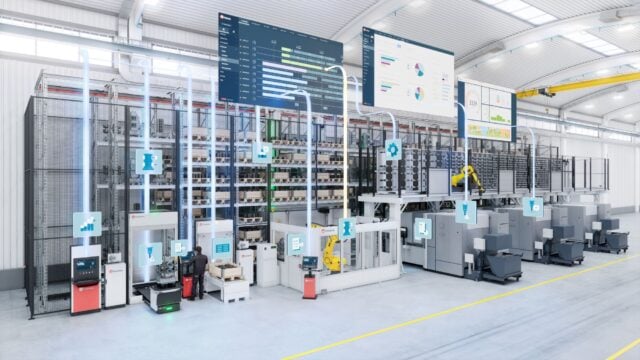
Fastems Unveils Revolutionary Automation Solutions at EMO Hanover 2025
Krefeld, Germany – June 20, 2025 – Fastems is set to unveil groundbreaking innovations at EMO…

The next wave of ecosystem thinking is hitting the manufacturing industry. In the future, the ecosystems have an even more significant influence in the industry than ever before. Are you familiar with the concept of Ecosystem Economy or ecosystem thinking? Let the specialists from Fastems, Harri Nieminen, Head of Innovation Development & Research at Fastems, and Abayomi Baiyere, Assistant Professor at CBS and Fastems’ Research Fellow, guide you through the concepts. Here are their answers to our basic questions about harnessing value in the ecosystem economy.
The idea is to shift away from the value-chain view where companies think they can develop their products and create value for their stakeholders on their own within a closed system of production. With ecosystem thinking, we understand that there is a lot of talent to leverage outside one’s division and more value to create with partners. When a company sees opportunities or challenges they cannot handle alone, they can seek to work together with partners, customers, and other stakeholders, to scale the benefits. Ecosystem thinking inverts traditional business logic in, for example, marketing, human capital, finance, R&D and innovation, and strategy.
The effects are best explained through practical examples. In marketing, businesses shift from outbound messaging to inbound servicing. For example, an eyewear company may send a user five different frame styles to try at home; the user posts the alternatives on their social networks to get votes on the best look and keeps the one or the ones they like the best. The user or customer is thereby harnessed to do part of the marketing to growth networks.
In terms of human capital, the emphasis shifts from internal experts to external crowds, and from subordinate dictation to community persuasion. For example, Apple is a master of leveraging the power of the crowd through its iOS community of content owners, developers, users, and brands. Their value is being created by the ecosystem. In terms of finance, corporate valuation models that underestimate market expansion due to network effects will fail to appropriately capture the value of such a business. For example, Instagram sold for $1B, not because of the contributions from their 13 employees but thanks to their 30 million users.
In terms of R&D and innovation, platforms are opened to third party contributions. Trying to create every feature on their own may lead a platform to its peril; a more profitable approach is to pick few key features to totally focus on and let other players (partners, competitors, customers, etc.) innovate everything else. In terms of strategy, this means that the goal shifts from control, entry barriers, and differentiation to more valuable market exchanges. There has been a fundamental change in the system, and network effects cannot be scaled inside as easily as they can be scaled on the outside. In ecosystem thinking, the focus of attention shifts from inside to outside, from me to we. Following the example of the software industry, we can see that users are important partners and co-creators and part of the equation in value creation.
Ecosystem thinking means shifting our attention from the closed systems of manufacturing within individual companies to looking outside the traditional value chain. According to research, the complexity of manufacturing lies in the increasing variety and intricacy of products, shorter lifecycles, speed, more pressure on quality, as well as a growing need for traceability. Products are expected to be personalised and delivered as “perfect orders”. These expectations take place in a global marketplace that includes geographically diverse supply chains and rapid shifts in business and technology. The challenge is to enable economically feasible manufacturing in these dynamic conditions, and achieving this requires true agility instead of mere flexibility, as well as a transformation from discrete to connected platforms, systems, and methods.
The way to go is by ecosystemic co-creation and the utilisation of ecosystemic value creation and shared operations. This will mean more integrated projects, developing the existing offering as well as launching new solutions. The future will hold more “E2E agility”. The manufacturing network will become more transparent with product-centric traceability chains, production-centric situational awareness and reactivity, network-level operations management, and capacity and resource sharing.
Fastems is strongly rooted in ecosystem thinking, and we thrive to be the forerunners of ecosystem economies within the manufacturing industry. Fastems is one of the members in Intelligent Industry as well as MEX Finland co-creation ecosystems. In these ecosystems, we are involved in several innovation development activities, resulting in, for example, concrete product concepts successfully approved by the market. Fastems is also taking part in the Trinity project, which is part of the EU Horizon 2020 framework program. The project’s objective is to create new technical and standardised solutions, tailored training and access to the European networks of robotisation for SMEs. Regarding the future of Fastems and ecosystem thinking, we understand that succeeding alone is a rocky road and one that often backfires. This is why we invest in international networks and ecosystems, which generate manufacturing solutions that meet the dynamically changing industry needs now and also in the future.
Be first to see all the updates from MTDCNC
Our newsletters frequency varies dependant on content
All the latest deals from the industry feature on our newsletters